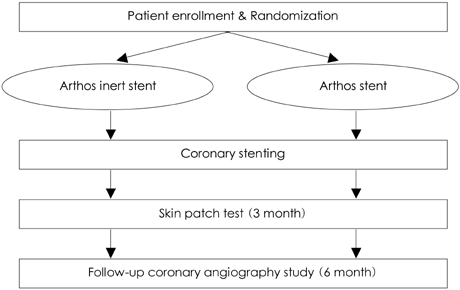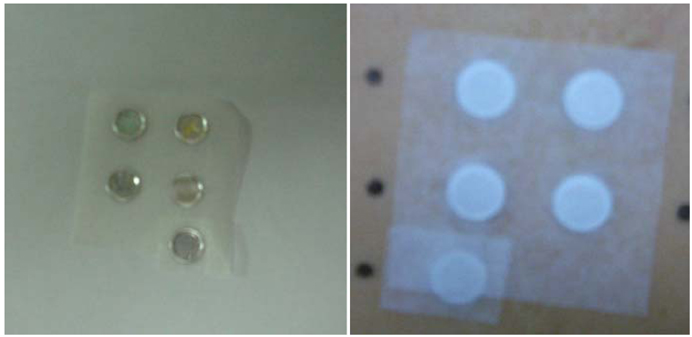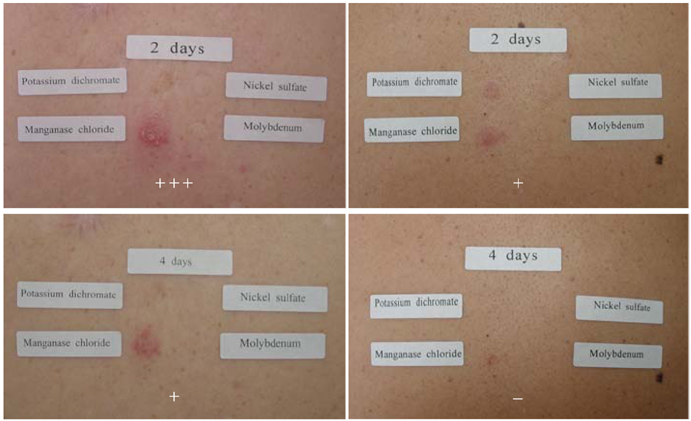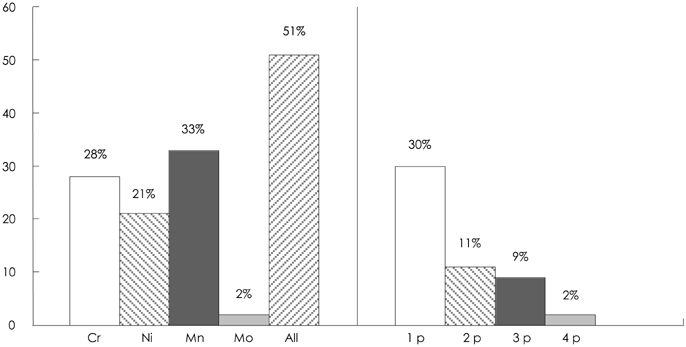Korean Circ J.
2007 Jun;37(6):258-264. 10.4070/kcj.2007.37.6.258.
The Effect of a New Carbon Stent for Preventing Restenosis-Prospective, Randomized Study for Preventing Metal Allergy
- Affiliations
-
- 1Department of Internal Medicine, Hae Dong Hospital, Busan, Korea.
- 2Department of Internal Medicine and 3Dermatology, Dong-A University College of Medicine, Busan, Korea. kimmh@dau.ac.kr
- KMID: 1825859
- DOI: http://doi.org/10.4070/kcj.2007.37.6.258
Abstract
-
BACKGROUND AND OBJECTIVES: Metal allergy has been reported to be related to stent restenosis. Therefore, we sought to investigate the incidence of metal allergy with new carbon stent with ion implantation technique and its relationship to restenosis.
SUBJECTS AND METHODS
Between April 2002 and June 2004, 128 patients (100 male, mean age 60+/-10 years) were included in this study. The clinical diagnoses of the study patients included 64 acute myocardial infarction, 24 unstable angina and 40 stable angina patients. Patients were randomly assigned to receive either an Arthos Inert Stent (the study group) or an Arthos stent (the control group), with follow-up angiography scheduled 6 months later. Three months after stent implantation, skin patch tests, for the detection of metal allergies, were performed with manganese, molybdenum, nickel and chromium.
RESULTS
There were no differences between the age, genders, risk factors and multi-vessel involvement between the two groups, as well as no differences in the angiographic parameters and restenosis (p>0.05). There were no differences in the positive rates of the skin tests between the Arthos stent and Arthos Inert stent groups or between the restenosis and no-restenosis groups (p>0.05). CONSLUSION: The new carbon stent, with ion implantation, did not reduce coronary restenosis. An allergic reaction was not related to the stent technology or stent restenosis.
MeSH Terms
Figure
Reference
-
1. Gruentzig A. Transluminal dilatation of coronary artery stenosis (letter). Lancet. 1978. 1:263.2. Schwartz RS, Murphy JG, Edward WD, Camrud AR, Vliestra RE, Holmes DR. Restenosis after balloon angioplasty: a practical proliperative model in the porcine coronary arteries. Circulation. 1990. 82:2190–2200.3. Kim MH. Coronary Intervention and Restenosis. Korean Circ J. 1999. 29:543–545.4. Alexander RW. Inflammation and coronary artery disease. N Engl J Med. 1994. 331:468–469.5. Kollum M, Kaiser S, Kinscherf ATVB, et al. Apoptosis after stent implantation compared with balloon angioplasty in rabits. Role of macrophages. Arterioscler Thromb Vacs Biol. 1997. 17:2383–2388.6. Kastrti A, Schomig A, Dirschinger J, et al. Increased risk of restenosis after placement of gold-coated stents with uncoated steel stents in patients with coronary artery disease. Circulation. 2000. 101:2478–2483.7. Kanerval L, Sipilamen MT, Estlander T, Zitting A, Jolanki R, Tarvainen K. Nickel release from metals, and a case of allergic contact dermatitis from stainless steel. Contact Dermatitis. 1994. 31:299–303.8. San Martin M, Barranco Sanz P, Lopez Serrano MC, Contreras Porta J. Allergy to dental prosthesis. Allergy. 1997. 52:690–691.9. Koster R, Vieluf D, Kiehn M, et al. Nickel and molybdenum contact allergies in patients with coronary in-stent restenosis. Lancet. 2000. 356:1895–1897.10. Kim MH, Cha KS, Kim JS. Transradial Interventions in Coronary Artery Disease: Comparison with Transfemoral Interventions. Korean Circ J. 1998. 28:1941–1952.11. Hillen U, Haude M, Erbel R, Goos M. Evaluation of metal allergies in patients with coronary stents. Contact dermatitis. 2002. 47:353–356.12. Freigert S. Manual of contact dermatitis. 1981. 2nd ed. Copenhagen: Munkguaard.13. Tanigawa N, Sawada S, Kobayashi M. Reaction of the aortic wall to six metallic stent materials. Acad Radiol. 1995. 2:379–384.14. Edelman ER, Seifert P, Groothuis A, et al. Gold-coated NIR stents in porcine coronary arteries. Circulation. 2001. 103:429–434.15. McKenna CJ, Camrud AR, Sangiorgi G, et al. Fibrin-film stenting in a porcine coronary injury model: efficacy and safety compared with uncoated stent. J Am Coll Cardiol. 1998. 31:1434–1438.16. van der Giessen WJ, Lincoff AM, Schwartz RS, et al. Marked inflammatory sequelae to implantation of biodegradable and nonbiodegradable polymers in porcine coronary arteries. Circulation. 1996. 94:1690–1697.17. Guthensohn K, Baythien C, Bau J, Fenner T, Grewe P, Koester R. In vitro analyses of diamond-like carbon coated stent. Reduction of metal ion release, platelet activation, and thrombogenecity. Thromb Res. 2000. 15:577–585.18. Svedman C, Tillman C, Gustavsson CG, Moller H, Frennby B, Bruze M. Contact allergy to gold in patients with gold-plated intracoronary stents. Contact Dermatitis. 2005. 52:192–196.19. Kim YH, Lee CW, Hong MK, et al. Randomized comparison of carbon ion-implanted stent versus bare metal stent in coronary artery disease: The Asian pacific MulticenterArthos Stent Study (PASS) trial. Am Heart J. 2005. 149:336–341.20. Iijima R, Ikari Y, Amiya E, et al. The impact of metallic allergy on stent implantation: metal allergy and recurrence of restenosis. Int J Cardiol. 2005. 104:319–325.
- Full Text Links
- Actions
-
Cited
- CITED
-
- Close
- Share
- Similar articles
-
- A Prospective Randomized Trial of Corticosteroids for the Prevention of Restenosis after Intracoronary Stent Implantation
- Systemic drug therapy and restenosis after drug-eluting stent implantation
- The Effects of a Carbon Ion Implantation Technique on In-stent Restenosis: Korean Multicentered Randomized Trial
- Drug-Eluting Stent Strut Fracture as a Cause of Restenosis
- Follow-up computed tomography can prevent stent migration after endoscopic ultrasound-guided hepaticogastrostomy





